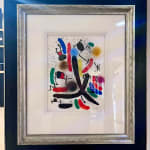Joan Miro
Excellent Condition
34.3 x 26 cm
Condition: Excellent
Protected with Acid Free French Mounts, museum grade glass and presented with Italian handmade frame.
Joan Miró's Lithograph I (1972) is part of his series of lithographs that reflect his signature abstract and surrealist style, created during a period when he was intensely exploring printmaking. Lithography, a medium that allowed for bold, spontaneous expression, was a natural fit for Miró, whose work often featured vibrant colours, organic shapes, and abstract forms.
Like much of Miró's work, Lithograph I is abstract, featuring playful shapes, forms, and symbols. His visual language often included biomorphic figures and spontaneous lines, evoking a childlike sense of wonder and freedom. The composition is balanced between dynamic and free-flowing gestures and a sense of careful design, characteristic of his mature style.
One of the defining features of Miró’s lithographs is his use of vivid, primary colours—reds, blues, yellows—often set against stark black lines or neutral backgrounds. In Lithograph I, he likely employed these colours to create a contrast between the simple shapes and the more complex, textured backdrop. His colours, though bold, are rarely aggressive; they convey a sense of energy and playfulness.
Miró often incorporated abstract symbols that could be interpreted as stars, birds, eyes, or other organic forms. These recurring motifs were central to his visual language, drawing from both nature and his subconscious. In Lithograph I, viewers may see echoes of these forms, though their meanings remain open to personal interpretation, reflecting Miró’s fascination with dreams, the cosmos, and a kind of universal language beyond conventional representation.
By the 1970s, Joan Miró had become an established figure in the world of modern art, having moved through surrealism, abstraction, and a variety of other avant-garde movements. During this time, Miró was increasingly focused on printmaking and sculpture, seeking to expand the limits of his artistic expression. Lithography, in particular, allowed him to experiment with layering, texture, and spontaneity.
Lithography, which involves drawing on a stone or metal plate with a greasy substance, was a perfect medium for Miró’s fluid and improvisational style. The process allowed for multiple copies of a single artwork while retaining the richness of his colour palette and the immediacy of his hand-drawn lines. His lithographs from this period are known for their high degree of experimentation, often blending the precision of printmaking with the spontaneity of drawing or painting.
Miró’s Lithograph I showcases his playful approach to abstraction, where the boundaries between recognizable objects and pure form blur. His work invites viewers to explore the emotional and psychological resonance of simple shapes and bold colours, reflecting his belief that art should be accessible and resonate on a fundamental human level.
Would you like us to stay in touch?
* denotes required fields
We will process the personal data you have supplied in accordance with our privacy policy (available on request). You can unsubscribe or change your preferences at any time by clicking the link in our emails.



